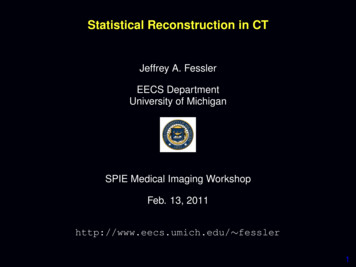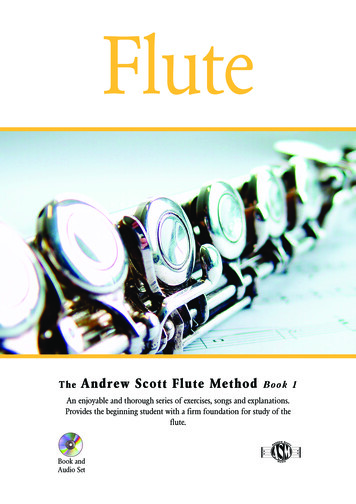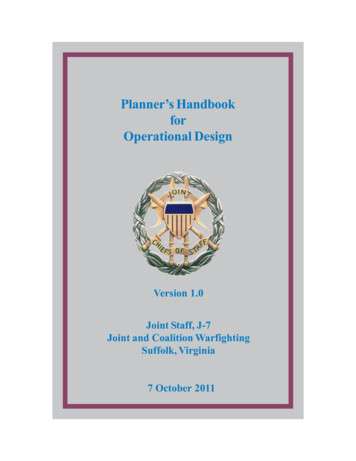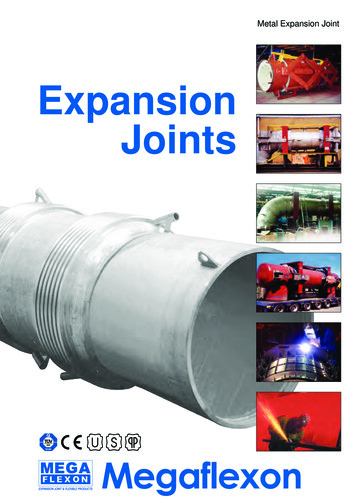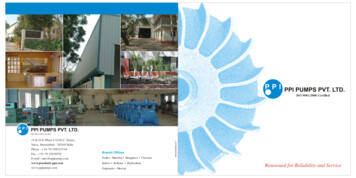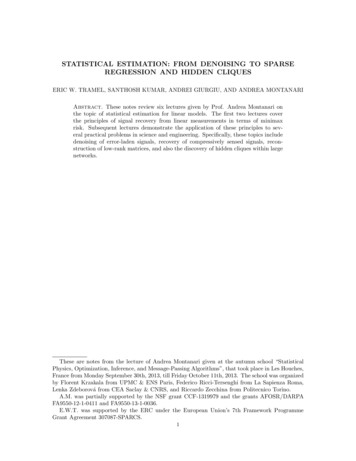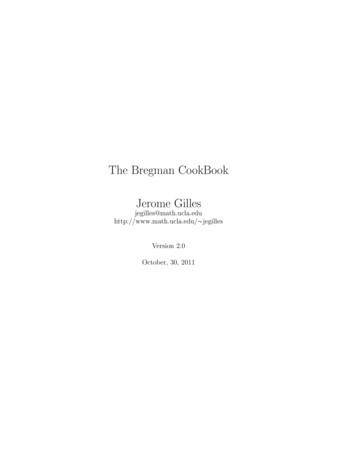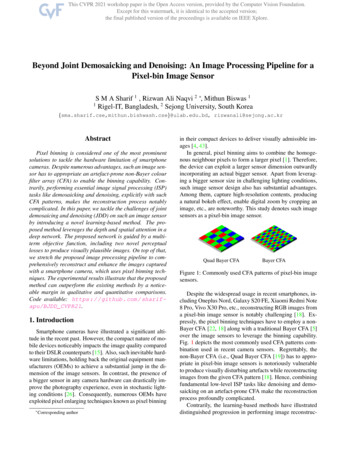
Transcription
Beyond Joint Demosaicking and Denoising: An Image Processing Pipeline for aPixel-bin Image SensorS M A Sharif 1 , Rizwan Ali Naqvi 2 *, Mithun Biswas 1Rigel-IT, Bangladesh, 2 Sejong University, South u.bd, rizwanali@sejong.ac.krAbstractPixel binning is considered one of the most prominentsolutions to tackle the hardware limitation of smartphonecameras. Despite numerous advantages, such an image sensor has to appropriate an artefact-prone non-Bayer colourfilter array (CFA) to enable the binning capability. Contrarily, performing essential image signal processing (ISP)tasks like demosaicking and denoising, explicitly with suchCFA patterns, makes the reconstruction process notablycomplicated. In this paper, we tackle the challenges of jointdemosaicing and denoising (JDD) on such an image sensorby introducing a novel learning-based method. The proposed method leverages the depth and spatial attention in adeep network. The proposed network is guided by a multiterm objective function, including two novel perceptuallosses to produce visually plausible images. On top of that,we stretch the proposed image processing pipeline to comprehensively reconstruct and enhance the images capturedwith a smartphone camera, which uses pixel binning techniques. The experimental results illustrate that the proposedmethod can outperform the existing methods by a noticeable margin in qualitative and quantitative comparisons.Code available: https://github.com/sharifapu/BJDD CVPR21.1. IntroductionSmartphone cameras have illustrated a significant altitude in the recent past. However, the compact nature of mobile devices noticeably impacts the image quality comparedto their DSLR counterparts [15]. Also, such inevitable hardware limitations, holding back the original equipment manufacturers (OEMs) to achieve a substantial jump in the dimension of the image sensors. In contrast, the presence ofa bigger sensor in any camera hardware can drastically improve the photography experience, even in stochastic lighting conditions [26]. Consequently, numerous OEMs haveexploited pixel enlarging techniques known as pixel binning* Correspondingauthorin their compact devices to deliver visually admissible images [4, 43].In general, pixel binning aims to combine the homogenous neighbour pixels to form a larger pixel [1]. Therefore,the device can exploit a larger sensor dimension outwardlyincorporating an actual bigger sensor. Apart from leveraging a bigger sensor size in challenging lighting conditions,such image sensor design also has substantial advantages.Among them, capture high-resolution contents, producinga natural bokeh effect, enable digital zoom by cropping animage, etc., are noteworthy. This study denotes such imagesensors as a pixel-bin image sensor.Quad Bayer CFABayer CFAFigure 1: Commonly used CFA patterns of pixel-bin imagesensors.Despite the widespread usage in recent smartphones, including Oneplus Nord, Galaxy S20 FE, Xiaomi Redmi Note8 Pro, Vivo X30 Pro, etc., reconstructing RGB images froma pixel-bin image sensor is notably challenging [18]. Expressly, the pixel binning techniques have to employ a nonBayer CFA [22, 18] along with a traditional Bayer CFA [5]over the image sensors to leverage the binning capability.Fig. 1 depicts the most commonly used CFA patterns combination used in recent camera sensors. Regrettably, thenon-Bayer CFA (i.e., Quad Bayer CFA [19]) has to appropriate in pixel-bin image sensors is notoriously vulnerableto produce visually disturbing artefacts while reconstructingimages from the given CFA pattern [18]. Hence, combiningfundamental low-level ISP tasks like denoising and demosaicking on an artefact-prone CFA make the reconstructionprocess profoundly complicated.Contrarily, the learning-based methods have illustrateddistinguished progression in performing image reconstruc-
ReferencePSNR: Deepjoint [12]PSNR:28.66 dBKokkinos [21]PSNR:31.02 dBDong [9]PSNR:30.07 dBDeepISP [35]PSNR:31.65 dBDPN [18]PSNR:32.59 dBOursPSNR:34.81 dBFigure 2: Example of Joint demosaicing and denoising on Quad Bayer CFA.tion tasks. Also, they have demonstrated substantial advantages of combining low-level tasks such as demosaicingalong with denoising [12, 21, 25, 9]. Most notably, some ofthe recent convolutional neural network (CNN) based methods [35, 16] attempt to mimic complicated mobile ISP andsubstantiate significant improvement in perceptual qualityover traditional methods. Such computational photographyadvancements inspired this study to tackle the challengingJDD of a pixel-bin image sensor and go beyond.This study introduces a novel learning-based method toperform JDD in commonly used CFA patterns (i.e., QuadBayer CFA [19], and Bayer CFA [5]) of pixel-bin imagesensors. The proposed method leverage spatial and depthwise feature attention [40, 14] in a deep architecture to reduce visual artefacts. We have denoted the proposed deepas a pixel-bin image processing network (PIPNet) in the restof the paper. Apart from that, we introduced a multi-termguidance function, including two novel perceptual lossesto guide the proposed PIPNet for enhancing the perceptualquality of reconstructed images. Fig. 2 illustrates an example of the proposed method’s JDD performance on a nonBayer CFA. The feasibility of the proposed method has extensively studied with diverse data samples from differentcolour spaces. Later, we stretched our proposed pipelineto reconstruct and enhance the images of actual pixel-binimage sensors.The contribution of this study has summarized below: Proposes a learning-based method, which aims totackle the challenging JDD on a pixel-bin image sensor. Proposes a deep network that exploits depth-spatialfeature attentions and is guided by a multi-term objective function, including two novel perceptual losses. Stretches the proposed method to study the feasibilityof enhancing perceptual image quality along with JDDon actual hardware.2. Related workThis section briefly reviews the works that are related tothe proposed method.Joint demosacing and denoising. Image demosaicingis considered a low-level ISP task, aiming to reconstructRGB images from a given CFA pattern. However, in practical application, the image sensors’ data are contaminatedwith noises, which directly costs the demosaicking processby deteriorating final reconstruction results [25]. Therefore, the recent works emphasize performing demosaicingand denoising jointly rather than traditional sequential approaches.In general, JDD methods are clustered into two major categories: optimization-based methods [13, 37] andlearning-based methods [12, 9, 21]. However, the later approach illustrates substantial momentum over their classical counterparts, particularly in reconstruction quality. Inrecent work, numerous novel CNN-based methods havebeen introduced to perform the JDD. For example, [12]trained and a deep network with millions of images toachieve state-of-the-art results. Similarly, [21] fuse themajorization-minimization techniques into a residual denoising network, [9] proposed a generative adversarial network (GAN) along with perceptual optimization to performJDD. Also, [25] proposed a deep-learning-based method supervised by density-map and green channel guidance. Apartfrom these supervised approaches, [10] attempts to solveJDD with unsupervised learning on burst images.Image enhancement.Image enhancement worksmostly aim to improve the perceptual image quality byincorporating colour correction, sharpness boosting, denoising, white balancing, etc. Among the recent works,[11, 44] proposed learning-based solutions for automaticglobal luminance and gamma adjustment. Similarly, [23]offered deep-learning solutions for colour and tone correction, and [44] presented a CNN model to image contrastenhancement. However, the most comprehensive image enhancement approach was introduced by [15], where the author enhanced downgraded smartphone images accordingto superior-quality photos obtained with a high-end camerasystem.Learning ISP. A typical camera ISP pipeline exploitsnumerous image processing blocks to reconstruct an sRGBimage from the sensor’s raw data. A few novel methodshave recently attempted to replace such complex ISPs by
learning from the convex set of data samples. In [35], theauthors proposed a CNN model to suppress image noisesand exposure correction of images captured with a smartphone camera. Likewise, [16] proposed a deep model incorporating extensive global feature manipulation to replacethe entire ISP of the Huwaei P20 smartphone. In another recent work, [24] proposed a two-stage deep network to replicate camera ISP.Quad Bayer Reconstruction. Reconstructing RGB images from a Quad Bayer CFA is considerably challenging.In [18] has addressed this challenging task by proposing aduplex pyramid network. It worth noting, none of the existing methods (including [18]) specialized for our targetapplications. However, their respective domains’ successinspired this work to develop an image processing pipelinefor a pixel-bin image sensor, which can perform JDD andgo beyond.In Eq. 2, B(·) presents the bottleneck block function, whichhas been inspired by the well-known MobileNetV2 [34].The main motive of utilizing the bottleneck block is to control the trainable parameters with satisfactory performance.Typically, pixel-bin image sensors are exclusively designedfor mobile devices. Therefore, we stress to reduce the trainable parameters as much as possible. Apart from the bottleneck block, DAB also incorporates a depth attention block,which has denoted as D(·) in Eq. 2. It is worth noting,this study proposes to adding the feature map of the depthattention block along with the bottleneck block to leveragethe long-distance depth-wise attention [14, 8]. Here, depthwise squeezed descriptor Z RC has been obtained byshrinking X̂ [x1 , . . . , xc ] as follows:3. MethodHere, AGP (c ) presents the global average pooling, spatialdimension, and feature map.Additionally, an aggregated global dependencies havepursued by applying a gating mechanism as follows:This section details the network design, a multi-term objective function, and implementation strategies.3.1. Network designFig. 3 depicts the proposed method’s overview, including the novel PIPNet architecture. Here, the proposed network exploits feature correlation, also known as attentionmechanism [14, 40, 8], through the novel components inU-Net [33] like architecture to mitigate visual artefacts.Overall, the method aims to map a mosaic input (IM ) asG : IM IR . Where the mapping function (F) learnsto reconstruct an RGB image (IR ) as IR [0, 1]H W 3 .H and W represent the height and width of the input andoutput images.Group depth attention bottleneck block. The novelgroup depth attention bottleneck (GDAB) block allowed theproposed network to go deeper by leveraging depth attention [14]. The GDAB block comprises of m Z number ofdepth attention bottleneck (DAB) blocks. Where the DABsare stacked consecutively and connected with short distanceresidual connection; thus, the network can converge withinformative features [8]. For any g-th member of a GDABblock can be represented as:Zc AGP (xc ) C1 Xxc (i)C iW τ (WS (δ(WR (Z))))(3)(4)Here, τ and δ represent the sigmoid and ReLU activationfunctions, which have applied after WS (·) and WR (·) convolutional operations, which intended to set depth dimension of features to C/r and C.The final output of the depth attention block has obtainedby applying a depth-wise attention map with a rescaling factor [8] described as follows:Dc Wc · Sc(5)Here, Wc and Sc represent the feature map and scaling factor.Spatial attention block. The spatial attention block ofthe proposed method has been inspired by recent convolutional spatial modules [40, 6]. It aims to realize the spatialfeature attention from a given feature map X as follows:F τ (FS ([ZA (X); ZM (X)])(6)Here, Wg , Fg 1 , and Fg represent the correspondingweight matrics, input, and output features. Hg (·) denotesthe function of group members (i.e., DAB).Depth attention bottleneck block. The proposed DABincorporates a depth attention block along with a bottleneckblock. For a given input X, the m-th DAB block aims tooutput the feature map X′ as:Here, F(·) and τ represent the convolution operation andsigmoid activation. Additionally, ZA and ZM present theaverage pooling and max pooling, which generates two 2Dfeature map as XA R1 H W and XM R1 H W .Transition Layer. The proposed network traverses different features depth to exploit the UNet like structure usingupscaling or downscaling operations. The downsamplingoperation has obtained on an input feature map X0 as follows:X′m Bm (X) Dm (X)F H (X0 )Fg Wg Fg 1 Hg (Fg 1 )(1)(2)(7)
Figure 3: Overview of the proposed method, including network architecture and submodules.Here, H (·) represents a stride convolutional operation.Inversely, the upscaling on an input feature map X0 hasachieved as:F H (X0 )(8)Here, H (·) represents the pixel shuffle convolution operation followed by the PReLU function, which intends toavoid checkerboard artefacts [3].Conditional Discriminator. The proposed PIPNethas appropriated the concept of adversarial guidance andadopted a well-established conditional Generative Adversarial Network (cGAN) [31]. The objective of the cGANdiscriminator consists of stacked convolutional operationsand set to maximize as: EX,Y log D X, Y .The proposed network G parameterized with weightsW, aims to minimize the training loss by appropriating thegiven P pairs of training images {IM t , IG t }Pt 1 as follows:WP1 XLT (G(IM t ), IG t )P t 1(9)Here, LT denotes the proposed multi-term objective function, which aims to improve the perceptual quality (i.e., details, texture, colour, etc.) while reconstructing an image.Reconstruction loss. L1-norm is known to be useful forgenerating sharper images [45, 35]. Therefore, an L1-normhas adopted to calculate pixel-wise reconstruction error asfollows:(10)Here, IG and IR present the ground truth image and outputof G(IM ) respectively.Regularized feature loss (RFL).: VGG-19 featurebased loss functions aim to improve a reconstructed image’sperceptual quality by encouraging it to have identical feature representation like the reference images [15, 30, 39].Typically, such activation-map loss functions represented asfollows:LFL λP LVGG(11)Where LVGG can be extended as follows:LVGG 3.2. Objective functionW arg minLR k IG IR k11k ψt (IG ) ψt (IR ) k1Hj W j C j(12)Here, ψ and j denote the pre-trained VGG network and itsj th layer.It is worth noting, in Eq. 11, λP denotes the regulator ofa feature loss. However, in most cases, the regulator’s valuehas to set emphatically, and without proper tuning, it candeteriorate the reconstruction process [39]. To address thislimitation, we replaced λP with a total variation regularization [36], which can be presented as follows:λR 1k Ov k k Oh kHj W j C j(13)Here,k Ov k and k Oh k present the gradients’ summation in the vertical and horizontal directions calculated
over a training pair. The regularized form of Eq. 11 can bewritten as:LRFL λR LVGG(14)Perceptual colour loss (PCL). Due to the smaller aperture and sensor size, most smartphone cameras are prone toillustrate colour inconsistency in numerous instances [15].We developed a CIEDE2000 [27] based on the perceptualcolour loss to address this limitation, which intends to measure the colour difference between two images in euclideanspace. Subsequently, the newly developed loss function encourages the proposed network to generate a similar colouras the reference image. The proposed perceptual colour losscan be represented as follows: LPCL E IG , IR(15)Here, E represents the CIEDE2000 colour difference[27].Adversarial loss. Adversarial guidance is known to becapable of recovering texture and natural colours while reconstructing images. Therefore, we encouraged our modelto employ a cGAN based cross-entropy loss as follows:LG Xlog D(IG , IR )(16)tHere, D denotes the conditional discriminator, which aimsto perform as a global critic.Total loss. The final multi-term objective function (LT )has calculated as follows:LT LR LRFL LPCL λG .LG(17)Here, λG presents adversarial regulators and set as λG 1e-4.3.3. Implementation detailsThe generator of proposed PIPNet traverses between different feature depth to leverage the UNet like structure asd (64, 126, 256), where the GDAB blocks of the proposed network comprise m 3 number of DAB block (alsorefer as group density in a later section). Every convolutionoperation in the bottleneck block of a DAB block incorporates 1 1 convolutional and a 3 3 separable convolution, where each layer is activated with a LeakyReLU function. Additionally, the spatial attention block, downsampling block, and discriminator utilize 3 3 convolutionaloperation. A swish function has activated the convolutionoperations of the discriminator. Also, every (2n 1)th layerof the discriminator increases the feature depth and reducesthe spatial dimension by 2.4. ExperimentsThe performance of the proposed method has been studied extensively with sophisticated experiments. This sectiondetails the experiment results and comparison for JDD.4.1. SetupTo learn JDD for a pixel-bin image sensor, we extracted741,968 non-overlapping image patches of dimension 128 128 from DIV2K [2] and Flickr2K [38] datasets. The imagepatches are sampled according to the CFA patterns and contaminated with a random noise factor of N (IG σ). Here,σ represents the standard deviation of a Gaussian distribution, which is generated by N (·) over a clean image IG . Ithas presumed that the JDD has performed in sRGB colourspace before colour correction, tone mapping, and whitebalancing. The model has implemented in the PyTorch [32]framework and optimized with an Adam optimizer [20] asβ1 0.9, β2 0.99, and learning rate 1e 4. The modeltrained for 10 15 epoch depending on the CFA patternwith a constant batch size of 12. The training process accelerated using an Nvidia Geforce GTX 1060 (6GB) graphicalprocessing unit (GPU).4.2. Joint demosaicing and denoisingWe conducted an extensive comparison with the benchmark dataset for the evaluation purpose, including BSD100[29], McM [41], Urban100 [7], Kodak [42], WED [28],and MSR demosaicing dataset [17]. We used only linRGB images from the MSR demosaicing dataset to verify the proposed method’s feasibility in different colourspaces (i.e., sRGB and linRGB). Therefore, we denoted theMSR demosaicing dataset as linRGB in the rest of the paper. Apart from that, four CNN-based JDD methods (Deepjoint [12], Kokkinos [21], Dong [9], DeepISP [35]) and aspecialized Quad Bayer reconstruction method (DPN [18])have studied for comparison. Each compared method’s performance cross-validated with three different noise levelsσ (5, 15, 25) and summarized with the following evaluation metrics: PSNR, SSIM, and DeltaE2000.4.2.1Quad Bayer CFAPerforming JDD on Quad Bayer CFA is substantially challenging. However, the proposed method aims to tackle thischallenging task by using the novel PIPNet. Table. 1 illustrates the performance comparison between the proposedPIPNet and target learning-based methods for Quad BayerCFA. It is visible that our proposed method outperforms theexisting learning-based methods in quantitative evaluationon benchmark datasets. Also, the visual results depicted inFig. 4 confirm that the proposed method can reconstructvisually plausible images from Quad Bayer CFA.
MethodDeepjoint [12]Kokkinos [21]Dong [9]DeepISP [35]DPN [18]PIPNetDeepjoint [12]Kokkinos [21]Dong [9]DeepISP [35]DPN [18]PIPNetDeepjoint [12]Kokkinos [21]Dong [9]DeepISP [35]DPN /0.9280/1.7939.44/0.9565/1.47Table 1: Quantitative evaluation of JDD on Quad Bayer CFA. A higher value of PSNR and SSIM indicates better results,while lower DeltaE indicates more colour consistency.ReferenceDeepjoint [12]Kokkinos [21]Dong [9]DeepISP [35]DPN [18]PIPNetFigure 4: Qualitative evaluation of JDD on Quad Bayer CFA.4.2.2Bayer CFAAs mentioned earlier, the pixel-bin image sensors have toemploy Bayer CFA in numerous instances. Therefore, theproposed PIPNet has to perform JDD evenly on Bayer CFA.Table. 2 illustrates the JDD performance of the proposedmethod and its counterparts on Bayer CFA. The proposedmethod depicts the consistency in Bayer CFA as well. Also,it can recover more details while performing JDD on BayerCFA without producing any visually disturbing artefacts, asshown in Fig. 5.4.3. Network analysisThe practicability of the proposed network and its novelcomponent has been verified by analyzing the network performance.4.3.1network consecutively. Fig. 6 depicts the importance ofeach proposed component through visual results. Apartfrom that Table. 3 confirms the practicability of novel components introduced by the proposed method. For simplicity,we combined all sRGB datasets and calculated the meanover the unified dataset while performing JDD on challenging Quad Bayer CFA.4.3.2Group density vs performanceDespite being significantly deeper and wider, the proposedPIPNet comprises 3.3 million parameters. The bottleneckblock employed in GDAB allows our network to control thetrainable parameter. Nevertheless, the number of parameters can be controlled by altering the group density (GD) ofthe GDAB blocks, as shown in Fig. 7. Additionally, Table. 4 illustrates the relation between GD and performancein both colour spaces while performing JDD.Ablation studyAn ablation study was conducted by removing all novelcomponents like attention mechanism (AM), PCL, and RFLfrom the proposed method and later injecting them into the5. Image reconstruction and enhancementTypically, smartphone cameras are susceptible to produce flat, inaccurate colour profiles and noisy images com-
σModelDeepjoint [12]Kokkinos [21]Dong [9]DeepISP [35]DPN [18]PIPNetDeepjoint [12]Kokkinos [21]Dong [9]DeepISP [35]DPN [18]PIPNetDeepjoint [12]Kokkinos [21]Dong [9]DeepISP [35]DPN 0.9539/1.7140.46/0.9547/1.46Table 2: Quantitative evaluation of JDD on Bayer CFA. A higher value of PSNR and SSIM indicates better results, whilelower DeltaE indicates more colour consistency.ReferenceDeepjoint [12]Kokkinos [21]Dong [9]DeepISP [35]DPN [18]PIPNetFigure 5: Qualitative evaluation of JDD on Bayer CFA.ModelBaseBase AMBase AM PCLBase AM PCL 01/0.9647/1.3141.82/0.9727/1.18Table 3: Ablation study on sRGB and linRGB images. Eachcomponent proposed throughout this study has an evidentimpact on network ,543Base AMBase AM PCLBase AM PCL 9608/1.6441.82/0.9727/1.18Table 4: Group density vs model performance. The numberof DAB blocks can impact network performance by makinga trade-off between parameters and accuracy.GD 9308/2.6134.64/0.9436/2.22GD 2GD 3Figure 7: Impact of GD while performing JDD (best viewedin zoom).Figure 6: Each proposed component plays a crucial role inJDD (best viewed in zoom).paring to professional cameras [15, 16]. To address this lim-itation and study the feasibility of a learning-based methodon an actual pixel-bin image sensor (i.e., Sony IMX586),we stretch our PIPNet as a two-stage network. Stage-I of
Quad Bayer reconstruction and enhancementBayer reconstruction and enhancementFigure 8: Qualitative comparison between pixel-bin image sensor output (i.e., Oneplus Nord) and the proposed PIPNet . Inevery image pairs, Left: Onelpus Nord and Right: Results obtained by PIPNet .the extended network performs JDD, as described in section. 4, and stage-II aims to enhance reconstructed images’perceptual quality by correcting colour profile, white balancing, brightness correction, etc. The extended version ofPIPNet is denoted as PIPNet . It worth noting, the PIPNet comprises the same configuration (i.e., hyperparameters, GD, etc.) as its one stage variant; however, it hastrained with smartphone-DSLR image pairs from the DPEDdataset [15], as suggested in a recent study [24]. Our comprehensive solution’s feasibility has compared with a recentsmartphone (i.e., Oneplus Nord), which utilizes the pixelbinning technique with actual hardware. We also developan android application to control the binning process whilecapturing images for our network evaluation. Additionally,the captured images were resampled according to the CFApattern prior to the model inference.method and Oneplus Nord. The proposed method outperforms Oneplus Nord in blind-fold testing by a substantialmargin. Also, it confirms that Quad Bayer reconstructionis far more challenging than a typical Bayer reconstruction. Therefore, the traditional ISP illustrates deficienciesby producing visually pleasing images on such CFA patterns, while the proposed method can deliver more acceptable results.5.1. Visual results6. ConclusionFig. 8 illustrates a visual comparison between OneplusNord and our PIPNet . The proposed method can improvethe perceptual quality of degraded images captured with anactual pixel-bin image sensor while performing ISP taskslike demosaicking, denoising, colour correction, brightnesscorrection, etc.5.2. User studyApart from the visual comparison, we perform a blindfold user study comparing Oneplus Nord and our proposed method. Also, we develop a blind-fold online testing method, which allows the users to pick an image frompairs of Oneplus Nord and our reconstructed image. Thetesting evaluation process is hosted online publicly by ananonymous user. Thus, the unbiased user opinion can becast to calculate the mean opinion score (MOS) for bothCFA patterns. Table. 5 illustrates the MOS of our proposedCFAQuad BayerBayerMethodOneplus NordPIPNet Oneplus NordPIPNet MOS 1.303.701.503.50Table 5: A user stud
advancements inspired this study to tackle the challenging JDD of a pixel-bin image sensor and go beyond. This study introduces a novel learning-based method to perform JDD in commonly used CFA patterns (i.e., Quad Bayer CFA [19], and Bayer CFA [5]) of pixel-bin image
